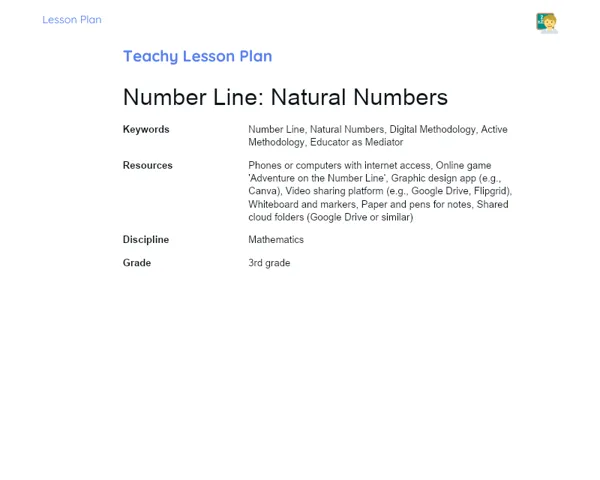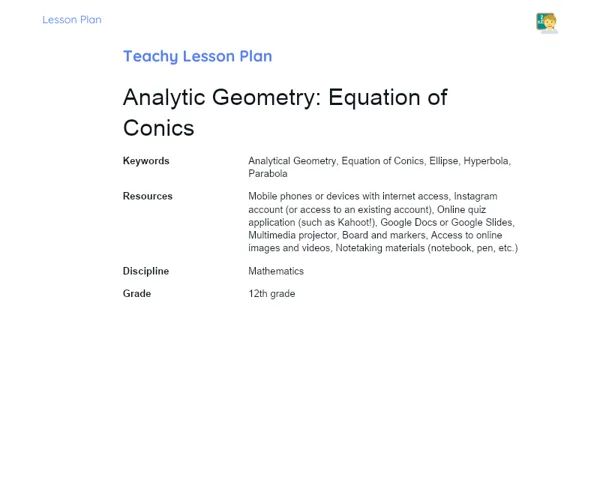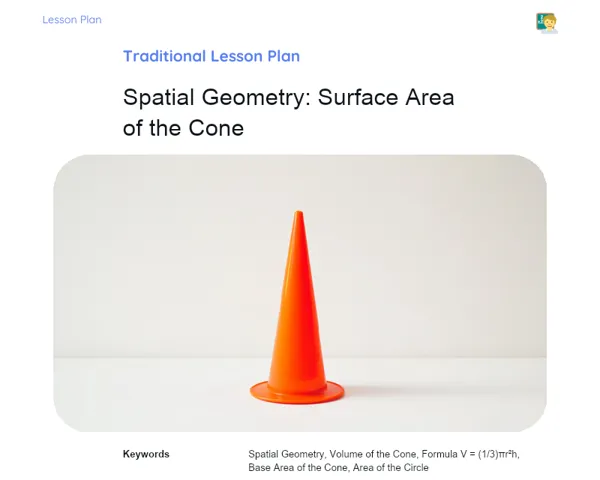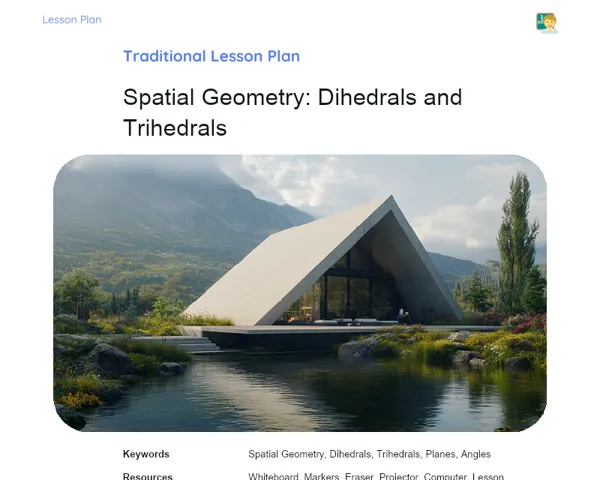Lesson Plan | Socioemotional Learning | Quadrilaterals: Trapezoid
| Keywords | Trapezium, Quadrilaterals, Geometry, Measures, Angles, Real-World Problems, Decision-Making, Socioemotional Skills, Self-Awareness, Self-Control, Social Awareness, RULER, Emotional Regulation, Guided Meditation, Group Work |
| Resources | Whiteboard, Markers, Ruler, Graph paper, Calculators, Activity sheets with trapezium problems, Projector (optional), Computers or tablets (optional) |
| Codes | - |
| Grade | 10th grade |
| Discipline | Mathematics |
Objective
Duration: 10 to 15 minutes
The aim of this step in the Socioemotional Lesson Plan is to lay a solid and understandable foundation on the topic of trapeziums. This will help students know exactly what to expect and which skills will be honed during the lesson. By setting specific objectives, students can better focus their attention and engage more deeply with the content, paving the way for the development of the socioemotional and technical skills necessary for a thorough understanding of the topic.
Objective Utama
1. Describe the key features of a trapezium.
2. Calculate side lengths and angles in a trapezium.
3. Solve real-world problems involving trapeziums, such as calculating the areas and perimeters of trapezoidal plots.
Introduction
Duration: 15 to 20 minutes
Emotional Warmup Activity
Guided Meditation for Focus and Concentration
Guided Meditation is a great technique to boost focus, presence, and concentration, helping prepare the mind for learning. It involves guiding students through a process where they concentrate on their breathing and visualize calming scenarios, which can lessen anxiety and enhance attention.
1. Ask students to sit comfortably in their chairs, with their feet flat on the ground and hands resting in their laps.
2. Instruct students to close their eyes and begin focusing on their breathing, inhaling deeply through the nose and exhaling through the mouth.
3. Lead a 5-minute guided meditation, encouraging students to envision a peaceful and safe space where they feel relaxed.
4. Ask students to visualise the details of this space, such as colours, sounds, and scents, while continuing their deep, rhythmic breathing.
5. After the meditation, ask students to slowly open their eyes and do a gentle stretch, moving their arms and legs to re-energise.
6. Wrap up the activity by asking students how they feel and if they’re ready to kick off the lesson.
Content Contextualization
The trapezium is a shape often encountered in our day-to-day lives, appearing in various objects and structures like bridges, rooftops, and even plots of land. Grasping its characteristics and knowing how to calculate its dimensions is critical not only for solving mathematical exercises but also for applying that knowledge in practical, real-life situations, such as construction and architecture. For example, while figuring out the area of a trapezoidal piece of land, we can ascertain the materials needed for a fence or a garden layout.
Furthermore, by learning about trapeziums, students will get the chance to cultivate important socioemotional skills, such as responsible decision-making and problem-solving, which are essential both in schoolwork and personal scenarios. Understanding the emotions tied to tackling mathematical challenges can assist students in managing anxiety and frustration better, fostering a more positive and fruitful learning atmosphere.
Development
Duration: 60 to 75 minutes
Theory Guide
Duration: 25 to 30 minutes
1. Definition of Trapezium: A trapezium is a quadrilateral with at least one pair of parallel sides. These parallel sides are termed the bases of the trapezium, while the other two sides are known as the non-parallel sides or legs.
2. Classification of Trapeziums: There are three main types of trapeziums: Isosceles Trapezium: Has congruent non-parallel sides (legs). Right Trapezium: Has two right angles. Scalene Trapezium: Has no congruent sides other than the bases.
3. Properties of Trapeziums: The sum of the internal angles of any trapezium is always 360 degrees. In an isosceles trapezium, the angles next to the bases are equal. The segment that connects the midpoints of the non-parallel sides is known as the median, is parallel to the bases, and is equal to the average of the lengths of the bases.
4. Important Formulas: Area of a Trapezium: A = (B + b) * h / 2, where B and b are the bases and h is the height. Median of a Trapezium: M = (B + b) / 2, where B and b are the bases.
5. Practical Example: Let’s consider a trapezoidal plot of land with bases measuring 20m and 10m, with a height of 5m. To find out the area, we’ll use the area formula: A = (20 + 10) * 5 / 2 = 75 m². This knowledge can be leveraged to determine the amount of material needed for fencing the land or for designing a garden.
Activity with Socioemotional Feedback
Duration: 30 to 35 minutes
Tackling Problems with Trapeziums
Students will be grouped and given practical problems related to calculating the measures and areas of trapeziums. Each group will need to solve a problem and present their findings to the class, elaborating on the steps followed and the formulas used. Afterward, socioemotional feedback will be provided using the RULER method.
1. Divide the class into groups of 4 to 5 students.
2. Hand out a different problem involving trapeziums to each group, like calculating the area of a piece of land or determining an unknown side’s measure.
3. Give each group 20 minutes to work on the problem using the formulas and concepts they learned.
4. Once the time is up, ask each group to share their solution with the class, explaining the steps they took and the formulas applied.
5. Encourage students to ask questions and provide feedback on the solutions discussed.
Discussion and Group Feedback
After the presentations, facilitate a guided discussion using the RULER method to offer socioemotional feedback to the students.
Recognize: Ask students to identify the emotions experienced during problem-solving, such as frustration, satisfaction, or anxiety. Understand: Explore the reasons behind these emotions by discussing the challenges faced and their impact on the group's performance. Name: Help students accurately label their emotions, thereby broadening their emotional vocabulary. Express: Encourage students to express their emotions respectfully, promoting empathy and consideration during presentations and discussions. Regulate: Suggest tactics to manage emotions, such as breathing exercises or practising positive thinking, to enhance focus and resilience in future tasks.
This approach nurtures socioemotional skills, creating a more collaborative and encouraging learning environment.
Conclusion
Duration: 20 to 25 minutes
Reflection and Emotional Regulation
To wrap up the lesson, invite students to reflect on the challenges faced during the trapezium problem-solving and how they handled their emotions. This reflection can be done through writing or in small group discussions. Ask students to share a paragraph or two about their feelings during the calculations and presentations, the emotions they encountered, and how they dealt with them. Encourage them to consider what worked well and what could be improved in terms of emotional regulation.
Objective: The goal of this activity is to encourage students to practice self-assessment and emotional control. By reflecting on their experiences, students can pinpoint effective strategies to handle challenging situations in the future, both academically and personally. This moment of contemplation solidifies socioemotional learning, fostering greater self-awareness and self-control.
Glimpse into the Future
As we close the lesson, ask students to set personal and academic goals linked to the content covered. Explain that these goals might involve improving their skills in solving geometry problems, staying composed under pressure, or enhancing teamwork. Encourage students to jot down these goals and share them with the class if they’re comfortable doing so.
Penetapan Objective:
1. Improve accuracy in mathematical calculations.
2. Boost confidence when presenting mathematical solutions to the class.
3. Develop personal strategies to manage anxiety during problem-solving.
4. Strengthen collaboration skills while working in a group.
5. Apply knowledge of trapeziums in real-world contexts, such as architecture or engineering projects. Objective: The aim of this section is to bolster student autonomy and the practical application of what they’ve learned. By setting personal and academic goals, students can direct their efforts towards specific areas of growth, fostering continuity in their academic and personal journeys. This approach helps them view learning as an ongoing process, better preparing them for future challenges.



